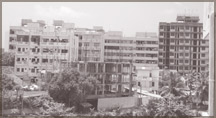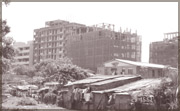|
DAILY NEWS ONLINE |
|
|
|
OTHER EDITIONS |
|
|
|
|
|
|
|
|
|
OTHER LINKS |
|
|
|
|
|
|
 |
 Colombo
- once a garden city turning into a concrete jungle
|
|
|
It is called "a Garden City', because of its high vegetation and one prime reason for this, is the low rise, low density, development the city had in the past.
It is for this very reason it became a model city in the early sixties and even Singapore which is called the model city in South East Asia today, got influenced from our city planning at the time of their economic revival.
But, what will be the future of Colombo, how it will look like and will it be still called a "Garden city" are matters of concern to all of us. City planning and development strategies, building guidelines and regulations will undoubtably decide the identity of our capital city.
Many plans have been drawn to develop the city its suburban environments which includes City Development Plan in 1975 and City of Colombo development plan in 1999. The last of its kind, Western Province Mega Polis Development Plan in 2004, was done by Cesma of Singapore and it appears that this plan is shelved though it had cost the state over 100 million rupees.
No consistency in development plans
Unfortunately, development plans of this country do not seem to have consistency and many successive governments have put forward such plans without considering the plans that were already in place and its success in implementing them.
|
|
Therefore, like the shifting of administrative capital to Sri Jayewardenepura Kotte, an excellent planning decision which got lost halfway, the effective implementation of these plans, assessment of their outcome and stirring it in the right direction have not been anyone's concern.
Therefore irrespective of how effectively these plans are implemented, Colombo as we all see is "developing" because the "demand" for development is ever increasing.
But it is important to be sure, especially because of the inconsistent, non monitored, politically interfered development plans, whether the city is progressing in the right direction. If not, the so-called "development" that we see today, could end up in a disaster in the future.
500 apartment buildings approved in Wellawatte alone
An active sector that is very vibrant at present in the city of Colombo, is the private high-rise residential developments projects which are commonly called as construction of apartments.
|
|
Just to indicate the scale of this emerging development pattern, there are over 500 apartments that have been approved for construction in the Wellawatta (Colombo 6) area alone, in addition to the high-rise apartments that are already built in almost in every byroad! The photograph 1 and 2 which is taken from Sri Saranankara Road, Dehiwala towards Wellawatta where highest demand for apartments exist, show the real danger that is happening.
Completely built up areas without any vegetation, architecturally dead buildings and a frustrating environment is already being created. The photograph 3, a view from Bambalapitiya towards Wellawatta, shows how the greenery is gradually getting replaced by bundles of buildings. Is this called development or is it real destruction?
The difference
In the past, living in apartments or as it is usually called then the "flats" was not very popular and it was limited to middle class and almost all such developments were done by the State.
|
|
The Maligawatta housing scheme in Colombo 10, Anderson flats in Colombo 5, Soysapura flats in Moratuwa are the main high-rise apartments that were done in the past.
The difference between these apartments and the ones that we see today is that they are "housing schemes" where wider roads, open spaces, services and utility facilities were planned and were part of the layout. They did not burden the adjoining environment.
The Liberty Plaza development and the Bambalapitiya Station Road Tower which did not materialize fully, were the first high-rise apartment projects that were done in collaboration with the private sector. What is important here is that these were for the rich and the upper middle class.
It is necessary to analyse why people have chosen to live in flats, a living style that was not popular merely less than a decade ago. Lack of infrastructure development, lack of public utilities in the outskirts, exorbitant land values in the city, low or no effective development in the regions and deterioration of individual security are the key factors for this change.
Public transport a major factor
The public transport is a major factor that is considered deciding ones' place of living. The public transport which was once the best in Asia has today fallen to a place of no return.
Limited number of buses controlled mainly by private bus owners which only operate in peak hours, Snails' speed railway service, unlimited importation of private cars which causes huge traffic jams have lead to living outside the city very discouraging.
In the morning and in the evening the main artery roads leading up and down to Colombo are full of bee lines of vehicles where many man-hours lost amidst fuel fumes. These long queues are full of private cars, vans, three-wheelers and very few fully packed buses explain the long story short.
It is simply because we have no transport policy which many other cities stricity plan and impose and this is one of the key factors for people to cling to the city. Central sewer and waste water system, water supply, garbage collection and properly maintained roads are either not available in the outstations or they do not satisfy basic demands.
For example a central sewer system only exists in Colombo and the other city that has such facility is Dehiwala where only sea side is covered. Ampara in the east is the only outstation town where a central sewer system existed, has now been abandoned due to misuse and due to lack of maintenance.
Public utilities like schools, hospitals and playgrounds are not developed in the outstations and suburbs. Specially, all the popular schools are located in Colombo and very little development has happened in the outskirts since independence. One of the main criteria of admitting students to schools is the distance and naturally people would like to be in the city.
Security a key factor too
Security is another major key factor for people to live in apartments and especially the Tamil community has decided to live in apartments for safety. Due to this reason most of the apartments are situated in Wellawatta area, Kotahena and in Modara areas where majority of occupants are Tamil Nationals.
In addition to this even other communities have also preferred to live in apartments, where private security is provided, as the activities of underworld gangs, contract killers and robbers have increased considerably in the past and has become a threat to the solitary dwellers.
Dangers
They are being the reasons to live in apartments, can the city of Colombo accommodate them is the Important issue. The town and Country Planning Ordinance, Housing and Town improvement Ordinance, Urban Development Authority Act are the major Acts and Ordinanc that govern and control any development in this country.
The following are the key factors that decide the physical nature of any building project in the greater Colombo area in addition to various reservations declared by State agencies.
1. Land use plan (Nature of development allowed in an area determined by UDA)
2. The floor area ratio (FAR, a factor decide the height of the building)
3. Plot size/dimensions and coverage (Maximum built up area for a premises - 65% for housing)
4. Compulsory open space in the rear (Rear Space)
5. Access Road
The Rear Space
The Rear Space was previously decided by a Light angle of 631/2* drawn from the rear of a site and width of the internal open spaces is also decided by the light angles drawn from either side of such open spaces (internal court yards), if official light and ventilation is drawn from such openings. No part of a building could get intersected by this imaginary line.
The plot coverage and the light angle which were introduced during colonial times guaranteed adequate gaps between the buildings and reasonable unbuilt land areas. This is very important because unlike in many other countries there are no special laws to protect the light and ventilation levels of the "Neighbours".
However, the regulations that were introduced in 1999 for the city of Colombo, drastic changes were done to the Rear Space and the light angle, by scrapping the light angle completely and limiting the rear space to a predetermined chart. Today after six years, we see the real effects of these changes.
The diagram 1 & 3 show the comparison of a residential development under the present and the previous regulations. In fact the nature and the magnitude all these apartment projects are directly linked to these amendments.
As a result of relaxation of rear space, buildings physically became close to each other causing adverse effect on light levels of the building itself and on neighbouring premises and internal court yards became so small that in several apartments the first two or three floors have to depend on artificial lights even during day time!
For example 3mX4m (129sq.ft) court yard (light well) can cater for four storeys and if it is eight storeys the size will have to be only 3mX5.3m (172 sq.ft.). (Refer diagram 2)
|
|
 |
|||
|
|||
|
|
|||
 |
|||
 |
|||
 |
|||
 |
|||




